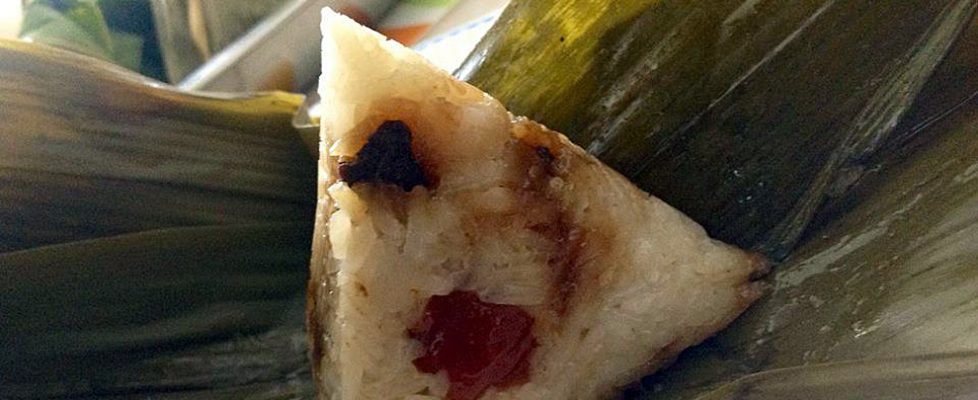Bak Chang – Rice Dumpling
Bak Chang or Zongzi (in Mandarin) is a traditional Chinese rice dumpling usually available around the time of Dragon Boat Festival. See here for information on the Penang International Dragon Boat Festival.
 Like many Chinese festivals and their associated foodie traditions, there is also a legend surrounding the origin of this yummy food. The story goes that a famous poet, Qu Yuan who lived during the Chu Dynasty, towards the end of the period of the Warring Kingdoms (from about 476 BC to 221 BC) tried to warn the King and his fellow countrymen of the expansion of the neighbouring Qin kingdom, with little success.
Like many Chinese festivals and their associated foodie traditions, there is also a legend surrounding the origin of this yummy food. The story goes that a famous poet, Qu Yuan who lived during the Chu Dynasty, towards the end of the period of the Warring Kingdoms (from about 476 BC to 221 BC) tried to warn the King and his fellow countrymen of the expansion of the neighbouring Qin kingdom, with little success.
When the capital of the Chu kingdom fell to a Qin general, the patriotic Qu Yuan was supposedly so overcome with grief that he drowned himself in the Miluo River. The Chu people threw packets of rice in to the river to keep the fish from feeding on the poet’s body.
Bak Zhang or Zhongzi as they are known today, are made with glutinous rice with a variety of filling, then wrapped in bamboo leaves, bound and tied together in a bundled. They are typically tetrahedral in shape although may range from a flatish square shape to a circular cylindrical shape.
I remember my grand mother preparing this once year in the evening, ready for the fifth day of the fifth month of the lunar calendar.
We would all sit on a ‘bangku’ (little foot stools no higher than 10 inches) each, surrounding a big bowl of un-cooked glutinous rice and smaller bowls of pork cooked in dark soya sauce, chestnuts, chinese mushrooms, lotus seeds, dried shrimp and salted duck egg yolk that go in to filling the dumpling.
She would start by making a conical-shaped container using the bamboo leaves and then adding some glutinous rice into the base.
The filling would then added in turn followed at the end by more glutinous rice before the ‘bak chang’ is sealed and tied to form it’s tetrahedral shape. The process was then repeated until all the filling was used up. ‘Bak chang’ is usually tied in bundles of ten or twelve.
When ready, the ‘bak chang’ is then left hanging in bundles overnight and then on the morning of the fifth day of the fifth month, the ‘bak chang’ would then be steamed or cooked in boiling water.
 Variations:
Variations:
Savoury Bak Chang
The ingredients above makes a Savoury Bak Chang, with big pieces of pork meat and soy sauce marinade. Giving the dumpling a rich brown colour.
Semi-sweet Bak Chang (Pua Kiam Tee Chang)
There is a second type of Bak Chang, a dumpling with Nyonya influence, which does not use the dark soy sauce marinade but instead replaces the ingredients with minced Pork, chopped candied winter melon, ground roasted peanuts and spices giving the cook glutinous rice a beige colour and sweet taste. Sometimes known as the Semi-sweet Bak Chang, this is a famous Peranakan Cuisine, a local culture and heritage of Penang.
Kee Chang
The third type of Chang is known as the Alkaline Water Chang, or Kee Chang. This type of change has no meat filling although is also made with glutinous rice. It is of a smaller size and easily distinguished from the bigger siblings. Kee Chang is typically eaten as a dessert with caramel syrup or white caster sugar as dipping. The glutinous rice is pre-treated with lye water thus giving it a soft and yellow texture and colour.
Where can I get Bak Chang: As this is a seasonal food, it is more common around June or July, although you might be able to find this all year round from certain stalls. Pulau Tikus Market, Chowrasta Market, Tanjung Bungah Market, MacCallum Street Market are some of the markets you would find this. A hawker stall that usually has this all year round is located in a little lane opposite Union School, along Burmah Road.
Heat Level: Non-Spicy
Photo Credit: Li Suan
Recipe Books
If you can’t get to Penang or simply want to prepare this at home, why not try one of the cook books below:




